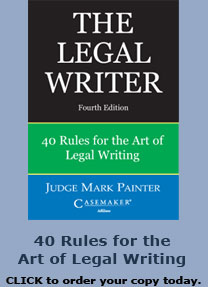Signs, signs, everywhere a sign
By Judge Mark P. Painter
Past columns have discussed the readability of various typefaces. Longtime readers will know that we can improve not only the appearance of our documents, but also the readability.
Because writing should make it easy on the reader, it only makes sense that we choose a font that is easy to read. You wouldn’t want to write a legal brief in Blue Highway Linocut or Old English Text—though the latter might make sense if you continue to use antiquated legalese.
Our court now uses Georgia for text and Arial for headings. My books (the ones I have a say in designing) are in Palatino. And the most important point is to use a serif font for text and a sans serif for headings. (See Rule 9 in The Legal Writer.) But that is in documents with a lot of text and headings. How about shorter writing, such as signs?
How often will lawyers come across a case where readability of signage is important? In automobile cases, the readability of traffic signs is sometimes important, as it is in other tort cases—“was the warning sign readable?” But event though there aren’t too many sign cases, readability in general is important. And signage is illustrative of the issues.
Sometimes, signs are just dumb. This one was photographed on an airplane – imagine that scene—by designer Dave Pitman of Vestal Design (www.vestaldesign.com).
What does that mean? Do we think anyone has ever read it? I hope other signs on airplanes are more readable. It’s even worse because it is in all caps. Never use all caps. Your brain recognizes word shapes—so many letters go above or below the line – and using all caps cuts off the shape.
Other signs use too many words: In the event of an emergency, please do not use the elevators, use the stairs. In the event of is unnecessary at best, and a distraction when there is an emergency. And non-lawyers don’t always use event that way. How about: In an emergency, use the stairs, not elevators.
A federal example
If you don’t believe all caps are much less readable, or you are not convinced that typeface matters in your documents, keep reading.
Reader Pierre Bergeron sent me an interesting article from the August 12 New York Times Magazine. Interstate highway signs are going to change to a more readable typeface. The one now—jokingly called Highway Gothic – is difficult to read, partially because the thick letters tend to blur, and it glares when light shines on it. With our boomer population approaching night-vision reduction, we definitely need a change.
The new type is Clearview, which is the product of extensive research on readability. The article is fascinating, and I recommend it, especially for those of you whose clients use signs.
These are examples of the change—the new are below.
Note that the new signs have ditched the all-caps format for the much more readable caps and lower-case letters in the headlines. Research on these signs shows that they are almost 30 percent more legible. That is, they can be read that much farther away—an obvious benefit to travelers going 55—and those over 55.
Readability
I always show the readability scores for the column. Statistics for this column (my writing only): 15 words per sentence, 4 percent passive voice, and grade level 9.
____________________________________
Mark Painter has served as a judge on the Ohio First District Court of Appeals for 12 years, after 13 years on the Hamilton County Municipal Court. Judge Painter is the author of 360 nationally published decisions, 115 legal articles, and six books, including The Legal Writer: 40 Rules for the Art of Legal Writing, which is available from http://books.lawyersweekly.com. Judge Painter has given dozens of seminars on legal writing. Contact him through his website, www.judgepainter.org.








